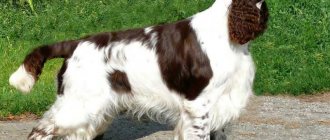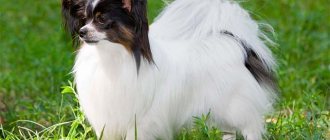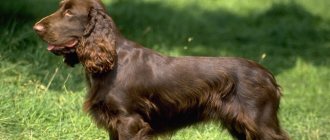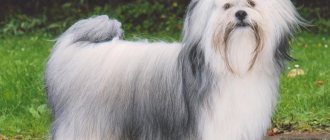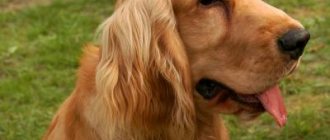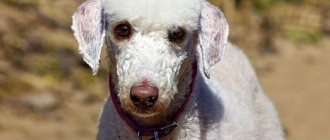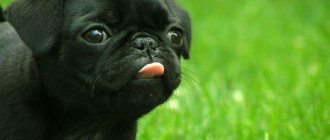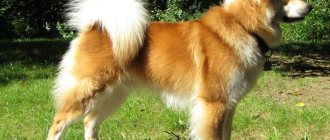/ Dogs / Dog breeds / The Field Spaniel is an active and friendly dog
0
1679
Article rating
If you are an active, cheerful person and for complete harmony and happiness you need a pet, then the Field Spaniel is just for you. We can bet that if you were asked to choose your favorite breed from several photos, you would choose the one where it is depicted. Why? Yes, because when you see such a kind face with smart and curious eyes, in addition to beautiful external features, you can’t help but fall in love. A description of this breed will be a pleasant discovery for lovers of four-legged animals, because it is difficult to find a more devoted and sympathetic friend.
Field Spaniel
Description of the breed
This dog was bred in the UK. The literal translation of the name of the breed is as follows: field, hunting spaniel. The Field Spaniel is very similar in appearance to the English Cocker, but it has slightly shorter limbs and a longer body.
In general, Field Spaniels are active, agile, hardy dogs that are ideal hunters in open areas. Due to its exceptional disposition, the pet has gained popularity as a decorative dog, in particular in the USA and Great Britain.
Origin story
At the end of the 18th and beginning of the 19th centuries, existing European spaniels began to be qualified, and with the growing popularity of exhibitions, many breeders began to develop their own breeds.
One of these was the Field Spaniel. It was created by crossing large black cocker spaniels with water spaniels and sussex dogs. In the second half of the 20th century, work began to restore the breed. Most modern Field dogs trace their pedigrees to the 4 dogs used in the breeding program of the 50s. Among all modern spaniels, the Field Spaniel is the rarest and smallest in number. Every year about 50 dogs are registered by the English Kennel Club. The Field Spaniel is recognized by the Fédération Cynologique Internationale.
Country of origin: Great Britain, 19th century. Finis Bullock crossed a Cocker Spaniel and a Sussex Spaniel to create a breed that resembles a Cocker in appearance but is black in color, slightly larger and has stronger bones. The result was a different dog, which not everyone initially liked: the body turned out to be much larger and heavier, the legs were shorter, and the working qualities were not considered the best.
Despite this, in 1892 the first standards were developed and approved, and the name field was given (translated as “field”). There were only four representatives of the breed in England. Mortimer Scott (English dog breeder) began further development. He developed a hunting breed with a strong body and good working qualities. The whole world still admires this dog.
During the Second World War, the breed almost disappeared; its enthusiastic fans saved it. At the end of the 40s of the 20th century, a new standard was developed and approved. Currently, dogs are especially common in the UK, Belgium, France and the Netherlands. In Russia they are confused with the Russian spaniel.
History and breed standard
The breed went through a series of dramatic changes before reaching its final form. According to experts, the pet was previously much larger. He was descended from a waterman, a cocker and a Sussex spaniel, and his weight was over 11 kilograms.
When the threat of extinction loomed over the breed, breeders began crossing the Field Spaniel with the English Springer Spaniel. The ancestors of modern representatives of the breed are called four Field Spaniels: Gorman Teal, Columbina from Teffont, Ronayne Regal, Elmburi Morvena from Rayulas.
Diseases and life expectancy
Most Field Spaniels are energetic and robust dogs with a life expectancy of 12-15 years. Some dogs can inherit health problems. The list of the most common diseases includes:
- Hip dysplasia
- Ophthalmological diseases (cataracts, progressive retinal atrophy, ectropion);
- Hypothyroidism;
- In adulthood, tumors are often registered;
- Allergies;
- There is a tendency to ear infections.
The breed is in good health. There are some diseases characteristic of field dogs:
- hip dysplasia;
- retinal atrophy (more often in older dogs);
- thyroid diseases.
Field dogs are prone to flat bladder cancer, which can cause death. If the dog is given proper care, it will live up to 12-14 years.
External signs
The head is long, the characteristic appearance of the head is given by the developed skull along with the protruding tubercle of the back of the head. The shape of the muzzle is neither blunt nor sharp, long, but not at all wide. Large nose. The eyes are almond-shaped and medium in size. The look is serious and soft. The ears are hanging, of medium width and length, set low. The neck is muscular, strong, long. The body is strong and stretched. The back is muscular and straight. The limbs are muscular and strong. The paws are round and medium in size. The tail is slightly curved or held straight, located below the level of the back.
Appearance
The Field Spaniel is a robust, strong and well-built dog. When judging, special attention is paid to harmony and balance; roughness or too heavy a body is unacceptable. Against the backdrop of a strong body, the dog has quite strong and long limbs. The breed is considered a working breed ; its coat should repel water and not interfere with swimming.
Bitches and males differ in appearance, but the differences are not too contrasting. The main differences are in behavior, look and temperament. The body of the bitches is slightly elongated , which is considered normal for any breed. The weight and height standards for Field Spaniels are not divided by gender:
- Ideal height 45.7 cm.
- Weight ranges from 15.8–22.6 kg.
Breed experts have no hesitation in saying that the Field Spaniel is the same as the Cocker Spaniel in its best years. It just so happened that the breed, which was once spoiled, was “reborn as a swan.” Modern cockers have many flaws, and most of them relate to health. Field Spaniels are distinguished by good health , and their appearance and performance are quite competitive.
Education and training
The pet is characterized by intelligence, so it easily grasps any commands. But at the same time, the Field Spaniel needs consistent, strict and flexible training. Therefore, it is better to start training while still a puppy. Only in this case will the puppy grow into an indispensable assistant, both in everyday life and on the hunt.
The pet needs a considerable amount of exercise, so this is an ideal dog for a sporty family. The Field Spaniel also enjoys the opportunity to explore and work. It is best to take him on a leash for daily walks. Moreover, the owner must make it clear to the dog that he is a leader, so that he will walk alongside.
Training
A hyperactive dog requires consistent, strict and flexible training from early childhood. Then the dog will become a reliable companion and hunter, an obedient assistant in everyday life. Fields become the dog of one owner and recognize him exclusively, the owner’s behavior is built accordingly. It is better if the dog is trained and undergoes OCD directly by the owner. This is not difficult for the owner, but the dog will understand the lesson much easier.
Fields don't look like bullies, but on the sports field it's only sometimes acceptable to let the dog off the leash. Pets do not tend to attack strangers and dogs. Training a Field Spaniel is an important issue. Preventing timidity in the future and, conversely, potential aggression is achieved through early socialization. As a rule, dogs love to frolic and express themselves actively.
They are easy to teach many techniques, but Field’s nature is sometimes too sensitive, one cannot resort to rough methods.
Training is built on special respect. The Field Spaniel is capable of expressing itself brilliantly during hunting, search activities and while tracking down prey. But the training of the presented individual must be flexible and patient!
A pronounced hunting instinct is Field’s leading characteristic. As a result, the dog is capable of hunting in any terrain. According to external data, the animal has sufficient strength and strength for hunting. As soon as he discovers game, he immediately tracks it. Hearing a shot, he runs after the game to bring it to the owner.
We invite you to familiarize yourself with: Scottish Fold cat (Scottish Fold): history and description of the breed, character and maintenance, nutrition and reviews of owners
about 46 cm
By the end of World War II, the breed was on the verge of extinction. But thanks to the efforts of Field lovers, after 1948 a new breed standard was developed and approved. Currently, these dogs are bred in Belgium, Great Britain, and France. The Field Spaniel is quite popular, but inferior to the Cocker.
The Field Spaniel is a beautiful and harmoniously built dog. Flexible, smart and balanced. Long walks are necessary; the dog does not feel well in mountainous conditions. The coat must be brushed and combed daily, and care must be taken not to allow dirt to accumulate between the toes.
General form. The Field Spaniel is strongly built, but without any signs of coarseness. This is a well-proportioned, well-balanced dog. The body is of medium length, the back is strong and muscular, the limbs are quite long, strong, and slender. The coat is straight or slightly wavy, not too short.
Characteristics of the breed. A very passionate, brave, active, agile, strong dog. Effective in any terrain. The search for game is carried out methodically, never losing contact with the owner. Having discovered the game, he makes it take off. A good fetcher: can bring back prey that is larger than it is in mass. She is distrustful and wary of strangers, but rarely barks. Among other spaniels it stands out for its intelligence and balance of character.
Head. Long, clean lines. The occipital protrusion is pronounced. The transition from the forehead to the muzzle is slightly pronounced. The muzzle is long, not very wide. The nose is wide.
Eyes. Almond shaped. Dark brown color.
Ears. Low set, medium length and width, hanging. Covered with long thick hair.
Frame. Stretched, strong. The neck is long and muscular. The chest is deep and well developed. The ribs are convex. The back is straight, strong, muscular. The loin is slightly convex and muscular.
Limbs. Strong, muscular. The paws are round, tightly closed, with strong toe pads.
Tail. Set low. The dog never carries it above the line of the back. Usually it is docked at 1/3 of the length. Covered with decorative hair.
Hairline. The coat is long, smooth, shiny, silky, not short or harsh, never curls, dense, and protects well from bad weather. The integumentary hair is abundant, located on the chest, on the sides of the body and on the back of the limbs.
Color. Solid black, brown (liver) or fawn. A combination of one of these colors with reddish-brown tan marks.
As already mentioned, the Field Spaniel is highly trainable. Moreover, it should be carried out regularly, strictly, without the use of physical punishment and harsh methods, because these dogs are very sensitive. They like to be involved, so they willingly go to classes. Capable of learning many commands. At the same time, it is important to immediately show who the leader is in the relationship, to earn trust and authority.
Since dogs are hyperactive, patience and consistency will be required. It is necessary to raise a pet from childhood. In this case, the dog will become especially obedient. Recognizes only the owner, so training and education cannot be transferred to other people.
Your pet needs early socialization to prevent it from becoming too shy or aggressive. If the owner of a Field Spaniel is not a fan of hunting, then the dog just needs to learn basic skills. A working spaniel should be taken out for training and decoy birds should be used.
Maintenance, care, health
The pet is adapted to life in a country house. Can be kept in an apartment only if he is given active and long walks every day.
Once or twice a week it is necessary to clean the coat with a brush, constantly inspecting the ears. They are protected from contamination. By the way, during the feeding period, it is recommended to fix the ears above the back of the dog’s head so that they do not fall into the bowl and get dirty. Show dogs are periodically trimmed, including the hair on the feet and inside the ears.
Features of maintenance and care
The Field Spaniel was born as a hunting dog and is ideal for living in rural areas. It is possible to keep a Field Spaniel in the city, although the dog is not intended for such a lifestyle. The animal needs space, regular long walks, and active physical activity. When indoors, the dog tends to be moderately active, but needs a wide, fenced yard.
If you prefer a passive lifestyle, the dog's temperament will not suit you. More often, Field Spaniels are bred in countries with cool climatic conditions.
We suggest you read: Effective deworming medications for cats and dogs
Spaniels have long hair and will require careful grooming, daily brushing and combing. An important point is caring for the hair between the toes, where hair and dirt turn into lumps, which is fraught with unpleasant consequences. Ear care is essential.
- Don't forget to brush your dog's fur a couple of times a week - use a special brush.
- Check your ears regularly and you can avoid possible inflammation.
- Field Spaniel puppies need coat care.
It is not difficult to care for the coat; the hair is long, not stiff, and hardly mats. On the contrary, they talk about the silkiness of the Field Spaniel. Wool will wonderfully protect the dog from the effects of wind. The cover is thick and abundant, located on:
- Limbs;
- Bockah;
- Chest area.
The Field Spaniel is not suitable for year-round outdoor living. The best option would be to keep it outside the city in a private house with a spacious yard. It adapts well to living in an apartment if enough attention is paid to walking. The dog is energetic and resilient and requires about an hour of exercise per day.
The Field Spaniel requires regular but simple grooming. It needs to be combed 1-2 times a week to avoid the formation of tangles and remove overripe hairs. There is no undercoat, so shedding is weak. Bathing as needed.
Dogs in the ring should look natural. Machine haircuts are only allowed on the head and front of the neck. The fringes are lightly trimmed with scissors. The rest is basic care. Nails should be trimmed as needed. The fur between the toes is trimmed. Keep ears, eyes and teeth clean.
Nutrition
The Field Spaniel is fed natural food or prepared food. If you go along the first path, then the dog’s diet should include the following products: meat, meat by-products, sea fish, dairy products (except milk), eggs, boiled vegetables, porridge (rolled oats, rice, buckwheat, millet). Be sure to give vitamin and mineral supplements.
From ready-made food, you can give preference to canned food or dry mixtures. They are given in accordance with the pet’s energy needs. It is better to give preference to premium food.
